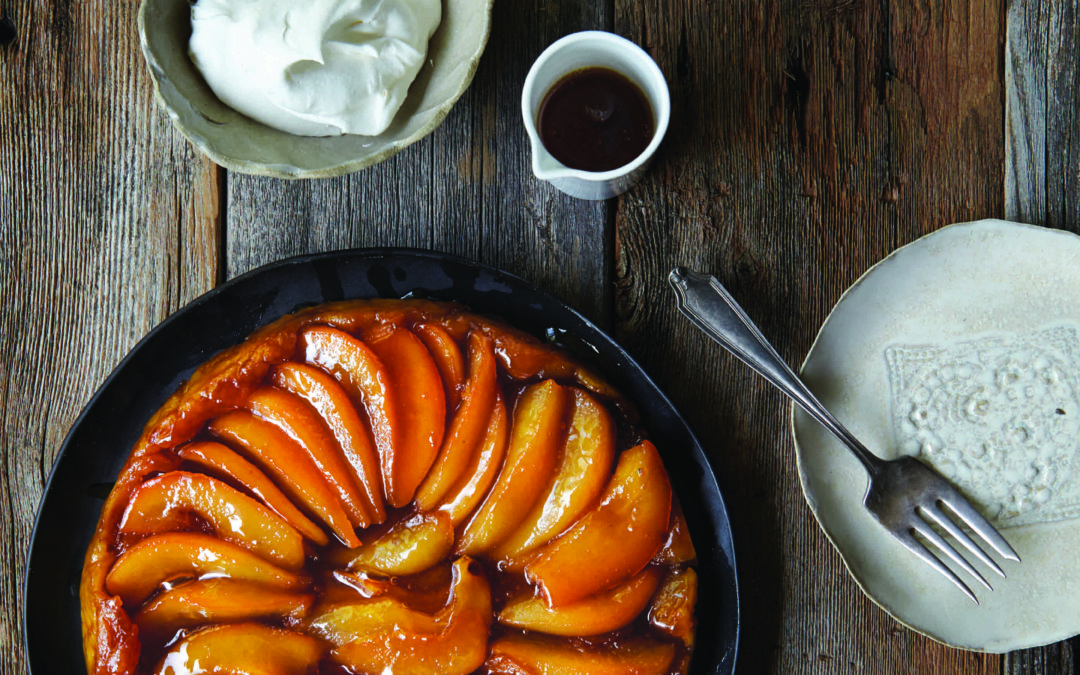Butter piecrust:
1 c. all-purpose flour
1/2 tsp. fine sea salt
2 T. sugar
6 T. unsalted butter
2 to 4 T. ice cold water
Pear filling:
4 small pears, or more as needed (Green Anjou or Bosc pears are best)
Juice from 1 lemon
1 1/4 c. sugar
1/4 c. water
2 T. unsalted butter
1. Make the piecrust: In a medium bowl, combine the flour, salt, and sugar, using a wire whisk to blend well. Cut the butter into 1/4” cubes. (For a very flaky result, place the flour mixture and butter in the freezer for 30 minutes.) Using a pastry cutter, cut the butter into the flour until the lumps are the size of peas. Add the water 1 T at a time and toss with a fork. Pinch a bit of the mixture between your fingers; if it holds together, you have added enough liquid.
2. Pour the mixture onto a lightly floured work surface. Cuddle the mixture into a ball by holding your hands on the counter and pressing the outside of the ball. You don’t want to over handle the dough. Using your hands, flatten the ball along the sides to push it into a square shape. (It will crumble and that is okay.) Using a pastry or regular knife, cut the dough into thirds and stack the thirds in a tower. Press to flatten, then cut and stack 5 more times. The last time, flatten and round the dough by cuddling your hands around the edges. Wrap the dough tightly in plastic wrap and refrigerate while you prepare the filling or make ahead and chill overnight.
3. Preheat the oven to 425°.
4. Make the filling: Peel the pears, then cut in half lengthwise. Remove the cores using a melon ball scoop or small cookie scoop. Place the pears on a sheet pan or in a large flat bowl in a single layer. Sprinkle the pears with the lemon juice and 1/4 c. of the sugar. Let stand while you prepare the caramel.
5. In a 9” cast iron skillet, combine the remaining 1 c. sugar and the water. Bring to a boil. Reduce the heat to medium-low and simmer, stirring occasionally and swirling the pan around the edge to be sure all the sugar dissolves. Cook until the sugar turns a rich brown caramel color, 6 to 8 minutes. Use a spoon to check the color since, in the dark pan, it will be difficult to see. Remove from the heat and carefully stir in the butter (it may spatter). Stir constantly until the butter is incorporated into the caramel. Let cool for 5 minutes.
6. Remove the pears from the pan or bowl, leaving the liquid behind; reserve the liquid. Cut the pears lengthwise into ½”-thick slices almost, but not quite through, the stem end. Arrange the pears on top of the caramel; cut side up in a fan around the edge of the pan and along the center of the pan. Fill in any gaps with additional pear slices.
7. Remove the dough from the refrigerator and place on a lightly floured work surface. With a floured rolling pin, roll the dough out to a 10” round. Place over the pears, tucking the dough in along the side of the pan. Prick several times with a fork. Bake on the middle rack of the oven until the crust is golden brown, 25 to 30 minutes. Let cool 10 minutes.
8. Carefully tilt the skillet and use a baster to drain the liquid into a saucepan. Add the reserved liquid from the raw pears to the saucepan. Bring to a boil and reduce to make a thickened caramel sauce that will coat the back of a spoon.
9. Invert a plate over the skillet and turn the plate and skillet over together quickly and carefully. If your cast iron skillet has a pour spout, it will leak a bit. Drizzle the top with the thickened caramel sauce. This is best served at room temperature or slightly warm.
Makes 1 (9”) tarte, serves 6
With 200 recipes curated from Lodge’s network of chefs and fans, Cast Iron Nation boasts a diverse array of recipes, stories and spectacular photography.
Get it at www.lodgemfg.com.




